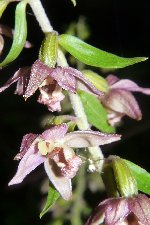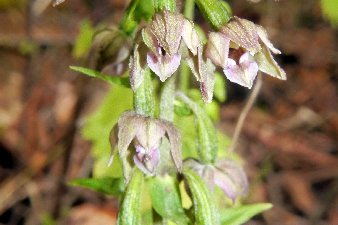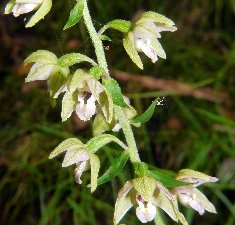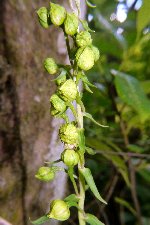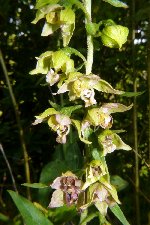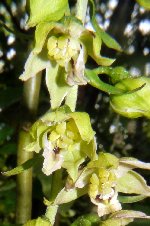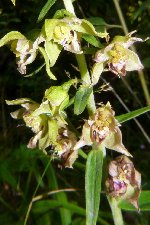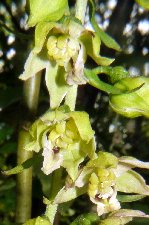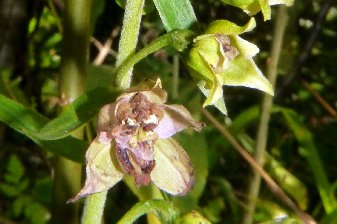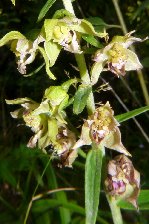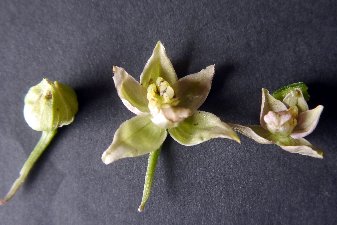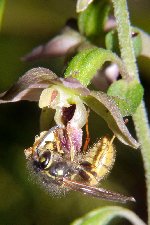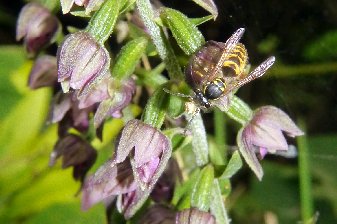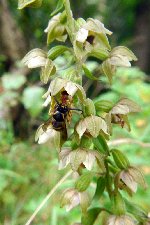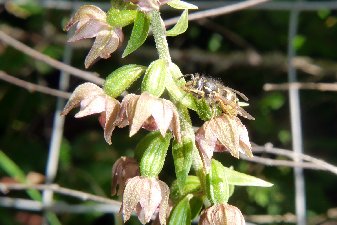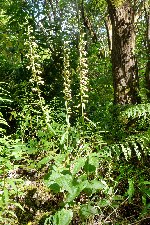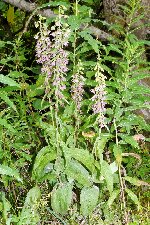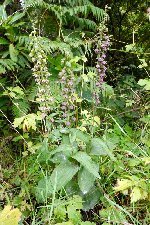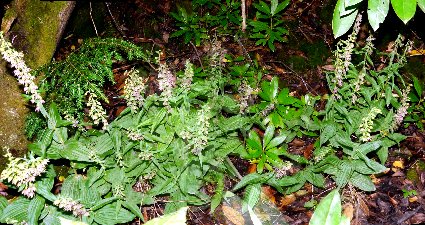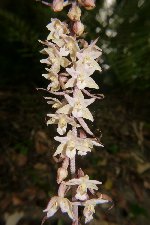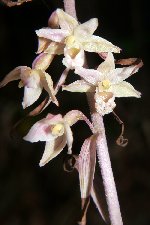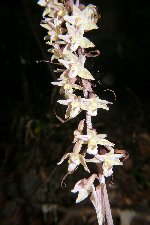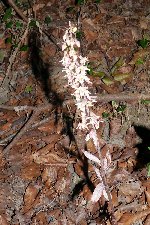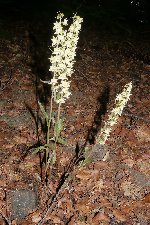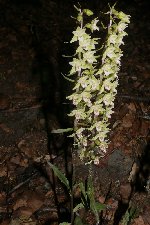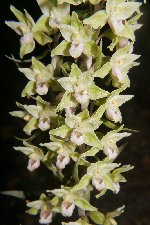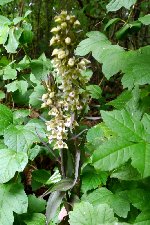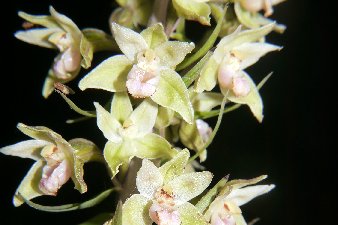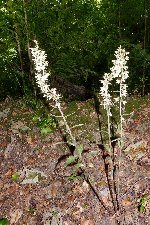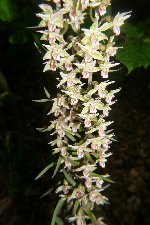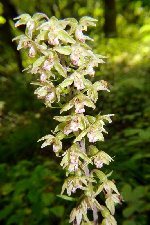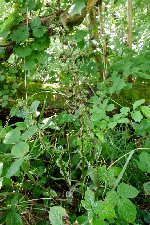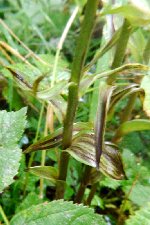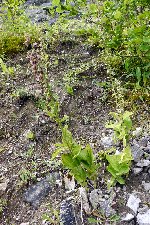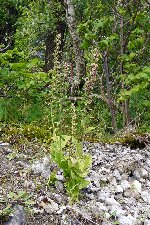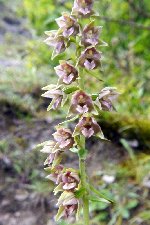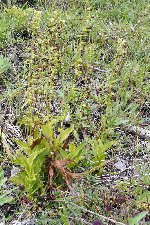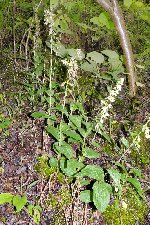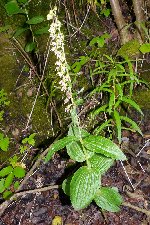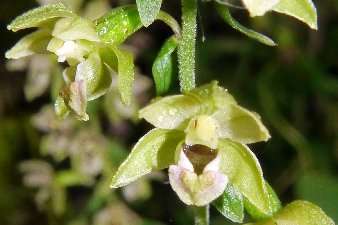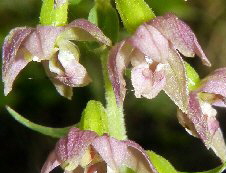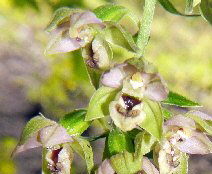|
|
|||||||||||||||||
|
|
|||||||||||||||||
 |
|
Nant-y-Frith, 4th and 10th August 2017 (SJ26395392) Here we are again at this new site, a couple of weeks later to catch the Broad-leaved Helleborines in flower, and they are. What becomes apparent, now we are on a proper trip, here is that the colony is much more extensive than we imagined. They must rival the Common Twayblades at Alyn Waters. The plants grow both sides of the track from the road to the bridge over the river below, a distance of perhaps half a mile - and probably beyond. You can see more further into the woods where there is some light. There must be well over 1,000 plants - suck on that Warburg! One clump alone has five times as many flowering plants as we saw at that reserve. And it was not usual to find flower spikes taller than waist height. The area is heavily wooded, so winds will be low and mainly follow the track. Add to that slow moving traffic swooshing the air along. on their way to the beauty spot, and it's not hard to imagine seed dispersal would be up and down the track, populating the margins but not much further beyond. Whilst discussing flower colour at Nant-y-Frith there is one observation I made. The lip shape here is variable with some heavy-bossed curled under lips, shield shaped lips and some with more pointed lips. A few lips are noted to have a sort of frilled edge. Another findingis illustrated on these photos. The flowers attracted a large numer of fruit flies, and these in turn pulled in small spiders. Those and there webs can be seen on the first and last photos below. Three plants of note; each and every flower is a large, swollen and ball-shaped, and ovaries are absent. Two grow together and the third grows directly below as the track doubles back on itself. There are some open flowers. They are 70% larger than regular flowers, with a sepal span of 25 mm compared to 16 mm. But it is the reproductive parts which are the most bizarre. One comment was "the John Merrick of Epipactis". This is quite appropriate. Each seems to have multiple columns, often 6 or 8, deformed due to compression in the bud. These seem to be decomposing rapidly. There were quite a few wasps out on both days, independently of the weather, and they are easily seen visiting the flowers and getting pollinia attached. The wasps appear to tolerate the pollinia while feeding, but when they stop to rest they try to remove it using their forelegs. This colony of Broad-leaved Helleborines is both well established and thriving colony. The helleborines grow on both sides of the road for approximately half a mile. There must be in excess of a thousand plants, and there are a good number them growing to waist height in small groups. In addition there was one clump with approximately 50 flowering spikes, though like the Rollright Stones, a repeat count will never yield the same answer. Coalbrookdale, 5th August 2017 Today's target is the Violet Helleborine var. rosea which I found in 2015, but failed to appear last year. And though it is easy to find, but you have to know where. When I first published photos of this plant one comment was that it was a semi-rosea - there was still some evidence of traces of chlorophyll. I would admit that there is not enough purple on the leaves and stem. That adds to the aesthetic, but low amounts would not disqualify it's identification. Of note is the fact that, like other Violet Helleborines in the immediate vicinity, this has one mis-developed flower, without a column or lip. This var rosea is not the easiest to photograph. Apart from having bright white flowers in a dull setting, it is also on a thirty five degree damp slope about 30 feet from the road. I have done my best, but again needed flash. The regular Violet Helleborines are looking good in their usual roadside spots, and a nice three-spiked plant is a great find beside a footpath. Despite their apparent dull colouration, this species seems to stand out when in the open in the dull light; almost glowing and ghostly. The position of this triplet growing daringly adjacent to a footpath highlights that this species tends to have the flowers all facing one way - towards the light, with the rear devoid of flowers. In total I count 23 spikes in flower and none damaged. More than one of the roadside plants has a flower without lip or column, and reduced numbers of perianth segments (in addition to the var rosea). This colony would appear to have a genetic predisposition to this sort of abnormality.
The Paradise Violet Helleborines seem a tad down in numbers this year with only 7 counted, but there are some very nice plants in this small number. No plants with mis-formed flowers are seen over the other side of the dale. Does this mean that the genetic abnormality occurred after the two parts of the larger colony became isolated from each other, and that pollinators do not cross the divide? Severn Valley Country Park, 5 August 2017 (SO748838) This site disappoints more often than it delights. In the wood I can only find two Violet Helleborines in flower. The very first one we saw here in 2013, by the path, is there but flowerless. Where we saw the pale, almost white flowers last year, there are none to be seen. Has a bench to sit on to view the river been moved to the spot, or am I looking at the wrong place? There are four VH, gone to seed, a little way along, so perhaps these were they. But hold on! Two of them have green and purplish stripy variegated leaves. Surely hyper-pigmented plants like these do not equate with the pale flowered ones.
Some clearance work has been undertaken along the riverside, but the trimmings have been placed along where the pale flowered plants were seen. This has meant that the undergrowth is a lot more luxuriant because no spring strimming took place, To be honest, it looks like the Helleborines there just couldn't compete. And to be frank, I am in two minds about management of reserves where orchids grow. Those sites with best displays often are those where man has not intervened, or intervened just a little. I have had a rant .... I mean made a few comments on managed sites in the My Ramblings section of this site. Minera Quarry, 6th August 2017 (SJ2566252102) This really has to be the last visit of the year here, and it is specifically for the Broad-leaved Helleborines. It is possible we missed them before, but there does seem to be more of these growing either side of the path leading into the quarry. You just need to look carefully and you will see them. I sneak a look at some below the quarry face. They are tall enough to be seen from the path, but their exposed location mean that they have largely gone over. The best are still those at the entrance to the tarmacced farm track and the slope behind. Perhaps more would be revealed on a climb up the hill to the quarry lip, where I know more grow. There is a string of six or seven flower spikes on the slope in a straight line - vegetative reproduction in action!
Shortly after this trip it is reported in the local paper that the North Wales Wildlife Trust was to hold an open day at the quarry. This follows last autumn's announcements that they had had talks with the site's owners. Their plans include a "tranformation into a spectacular nature reserve and community wildlife asset". I am sure the aims are laudable and earnest, but I would worry about them over-managing the site and encouraging visitors with bikes and worse. The wildlife has done very well without human intervention, apart from occasional cattle and sheep grazing. What can the trust do to improve it apart from perhaps filling the potholes where you can park and erecting a WC. Thousands of orchids could be trampled if there is an influx of visitors attracted to see the peregrines nesting. Let nature run the quarry, and we shall a succession of habitats there with an evolving flora and fauna.
|
|
|
||||||||||||||
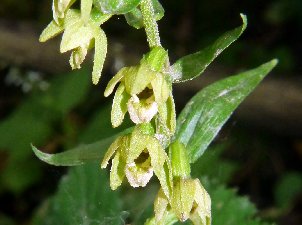
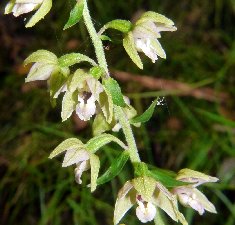
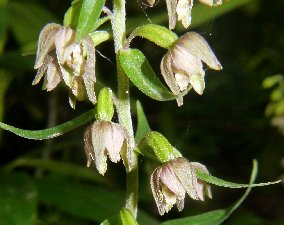
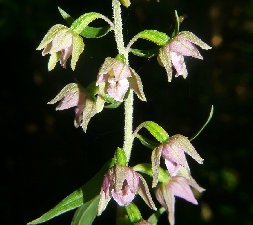
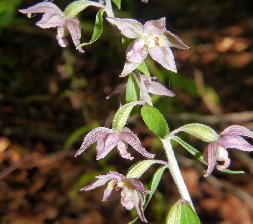
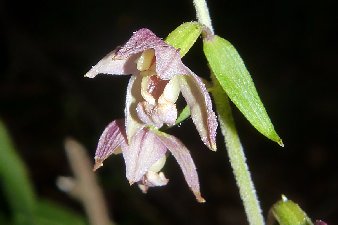
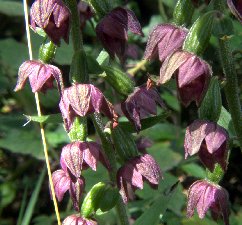
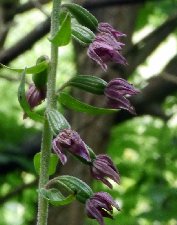
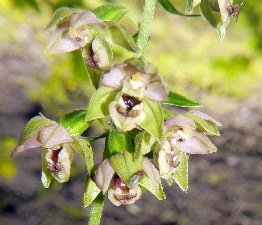 At both Minera Quarry and the Lead Mines there was a frequent finding of Broad-leaved Helleborines with a dull pale flower where the lip bosses were much darker - almost a dirty chocolate colour (as shown). This feature is also absent from the Hosely Epipactis too. There were none of those here. To me that suggests that his population is different from the other two sites. As those are linked by the trackbed of the former mineral railway it is no surprise that their Broad-leaved Helleborines are parts of one larger population. Could the have been here since the days of the railway even?
At both Minera Quarry and the Lead Mines there was a frequent finding of Broad-leaved Helleborines with a dull pale flower where the lip bosses were much darker - almost a dirty chocolate colour (as shown). This feature is also absent from the Hosely Epipactis too. There were none of those here. To me that suggests that his population is different from the other two sites. As those are linked by the trackbed of the former mineral railway it is no surprise that their Broad-leaved Helleborines are parts of one larger population. Could the have been here since the days of the railway even?